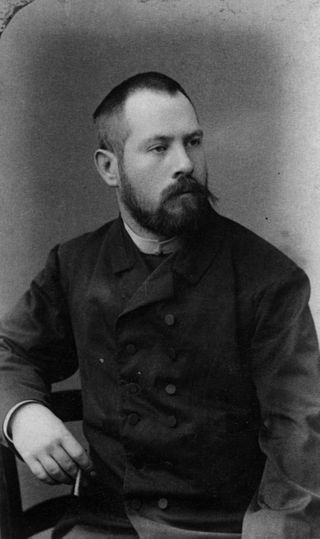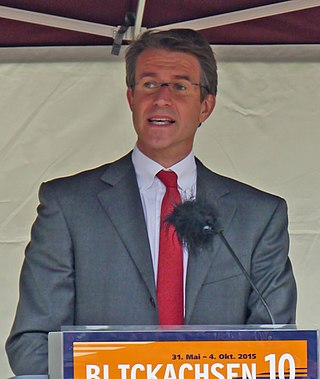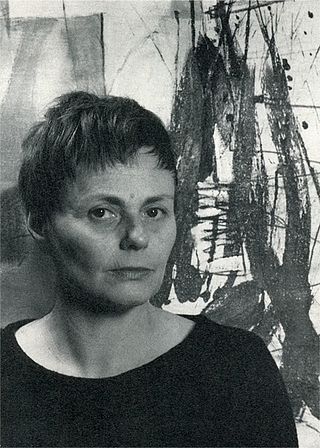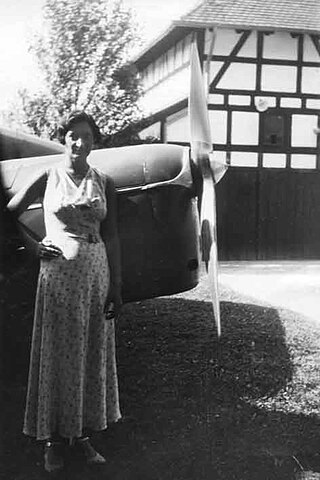Silvia Quandt (born 1937) is a German artist. [1]
Silvia Quandt (born 1937) is a German artist. [1]
Quandt was born in 1937 in Berlin, the only child of the marriage between a German industrialist and prominent Nazi, Herbert Quandt, a man who was eventually the major shareholder of BMW, and his first wife Ursel Munstermann. Her parents divorced in 1940 and Silvia stayed with her mother.
She studied at the Academy for Graphic Arts in Munich and then trained as a commercial artist. She has worked as a freelance painter since the 1960s. She received the Burda Award in 1968 and the Swabian Art Award in 1969. Works by Quandt can be seen today at the Bayrischen Staatsgemäldesammlung (Bavarian State Painting Collection) and in the Haus der Kunst Art Museum in Munich. Quandt's paintings and graphic works are ascribed to Fantastic Realism, characterised by a tendency towards the Surreal and Romanticism. She has had exhibitions in Munich, Düsseldorf, Münster, Mannheim, Bremen, London, Paris and Zurich.
The documentary The Silence of the Quandts described the role of the Quandt family businesses during the Second World War. It disclosed information about the use of slave labourers in the family's factories during World War II. A later study funded by the Quandt family themselves concluded that "the Quandts were linked inseparably with the crimes of the Nazis". [2] [3] As of 2008 no compensation, apology or memorial at the site of one of their factories, have been permitted. BMW was not implicated in the report.
Quandt lives and works in Munich. Before her father's death in 1982, she received extensive investments and property which are controlled through various private companies, in particular Silvia Quandt Capital GmbH. While her younger siblings Susanne Klatten and Stefan Quandt (from her father's third marriage) have fortunes estimated in the billions of dollars mostly from substantial large holdings in public companies such BMW, Altana and Varta, Silvia Quandt's fortune is more difficult to estimate as it is mainly controlled through private holding companies.

Bayerische Motoren Werke AG, commonly abbreviated to BMW, is a German multinational manufacturer of luxury vehicles and motorcycles headquartered in Munich, Bavaria, Germany. The company was founded in 1916 as a manufacturer of aircraft engines, which it produced from 1917 to 1918 and again from 1933 to 1945 creating engines for aircraft that were used in the Second World War.

Emil Nolde was a German-Danish painter and printmaker. He was one of the first Expressionists, a member of Die Brücke, and was one of the first oil painting and watercolor painters of the early 20th century to explore color. He is known for his brushwork and expressive choice of colors. Golden yellows and deep reds appear frequently in his work, giving a luminous quality to otherwise somber tones. His watercolors include vivid, brooding storm-scapes and brilliant florals.

Franz Moritz Wilhelm Marc was a German painter and printmaker, one of the key figures of German Expressionism. He was a founding member of Der Blaue Reiter, a journal whose name later became synonymous with the circle of artists collaborating in it.

Lovis Corinth was a German artist and writer whose mature work as a painter and printmaker realized a synthesis of impressionism and expressionism.

Stefan Quandt is a German billionaire heir, engineer and industrialist. As of October 2021, his net worth is estimated at US$23.2 billion and ranked at number 89 on Bloomberg Billionaires Index.

Susanne Hanna Ursula Klatten is a German billionaire heiress, the daughter of Herbert and Johanna Quandt. As of January 2022, her net worth was estimated at US$23.4 billion, and the richest woman in Germany and the 50th richest person in the world according to the Bloomberg Billionaires Index.

Johanna Maria Quandt was a German billionaire businesswoman and the widow of Herbert Quandt, an industrialist and prominent Nazi. When she died in 2015 she was the 8th richest person in Germany, the 77th richest person in the world, and the 11th richest woman worldwide according to Forbes.

Adolph Friedrich Erdmann von Menzel was a German Realist artist noted for drawings, etchings, and paintings. Along with Caspar David Friedrich, he is considered one of the two most prominent German painters of the 19th century, and was the most successful artist of his era in Germany. First known as Adolph Menzel, he was knighted in 1898 and changed his name to Adolph von Menzel.

Harald Quandt was a German industrialist, the son of Günther Quandt and Magda Behrend Rietschel. His parents divorced and his mother was later married to Joseph Goebbels. After World War II, Quandt and his older half-brother Herbert Quandt ran the industrial empire left to them by their father owning a stake mainly in Germany's luxury car manufacturer BMW and the electric battery producer VARTA which emerged from Accumulatoren-Fabrik AFA which still belongs to the family.
Herbert Werner Quandt was a German industrialist and member of the Nazi Party credited with having saved BMW when it was at the point of bankruptcy and made a huge profit in doing so. Quandt also oversaw the use at his family's factories during World War II of tens of thousands of slave labourers, many of whom perished.

Günther Quandt was a German industrialist who founded an industrial empire that today includes BMW and Altana, a car and chemical company, respectively. Between, 1921 and 1929 he was married to Magda Ritschel, later the wife of Nazi Propaganda Minister Joseph Goebbels. In the 1930s he joined the Nazi Party, becoming one of its strong financial supporters.

Karl Christian Ludwig Hofer or Carl Hofer was a German expressionist painter. He was director of the Berlin Academy of Fine Arts.

Georg Muche was a German painter, printmaker, architect, author, and teacher.

The Gurlitt Collection was a collection of around 1,500 art works assembled by Cornelius Gurlitt, the son of one of Hitler's official art dealers, Hildebrand Gurlitt (1895–1956), and which was found to have contained several artworks looted from Jews by the Nazis.
Käthe Fanny Schuftan was a German Jewish artist whose paintings and drawings expressed both human suffering and the aspiration of spirit, in the mid 20th century. Josef Paul Hodin wrote that she "worked in an Expressionist style reminiscent of Käthe Kollwitz' social pathos". An artist at the time of the Weimar culture, she was tortured and imprisoned by the Nazis in the early 1930s, and her work was destroyed. She escaped in 1939, arriving in Manchester, England, not long before the outbreak of World War II; she lived and worked there until her death in 1958.

Irma Hünerfauth, also known as IRMAnipulations was a German painter, sculptor and object artist who turned junkyard scrap into sculptures, machines and kinetic art objects that mocked consumer society. She opposed traditional academic art, rebelled against academism and followed radical contemporary art trends in post-war Germany. Through her work she is related with the concept of artists from the post-war modernity as well as the Nouveau Réalisme group of artists, such as Niki de Saint-Phalle, Jean Tinguely, Arman as well as Daniel Spoerri.

Max James Emden was a German chemist, wholesale merchant, art collector and from 1926 owner of the Brissago Islands on Lake Maggiore. Some of Emden's properties, including valuable paintings, have been the object of Nazi-era restitution claims. How his legacy has been handled has sparked a debate in Germany about the erasure of information concerning the Nazi era and inspired films about his life.

Agathe Saulmann and Ernst Saulmann were a German-Jewish collector couple. They were victims of persecution under the Nazis.
Valerie Vally Eisler was an Austrian Jewish art collector who was robbed and murdered by Nazis in the Holocaust.

Margarete Oppenheim was a German art collector and patron. She was among the first personalities to collect works of modern art in Germany and owned one of the largest collection in Germany. She is also known as Margarete Oppenheim-Reichenheim.